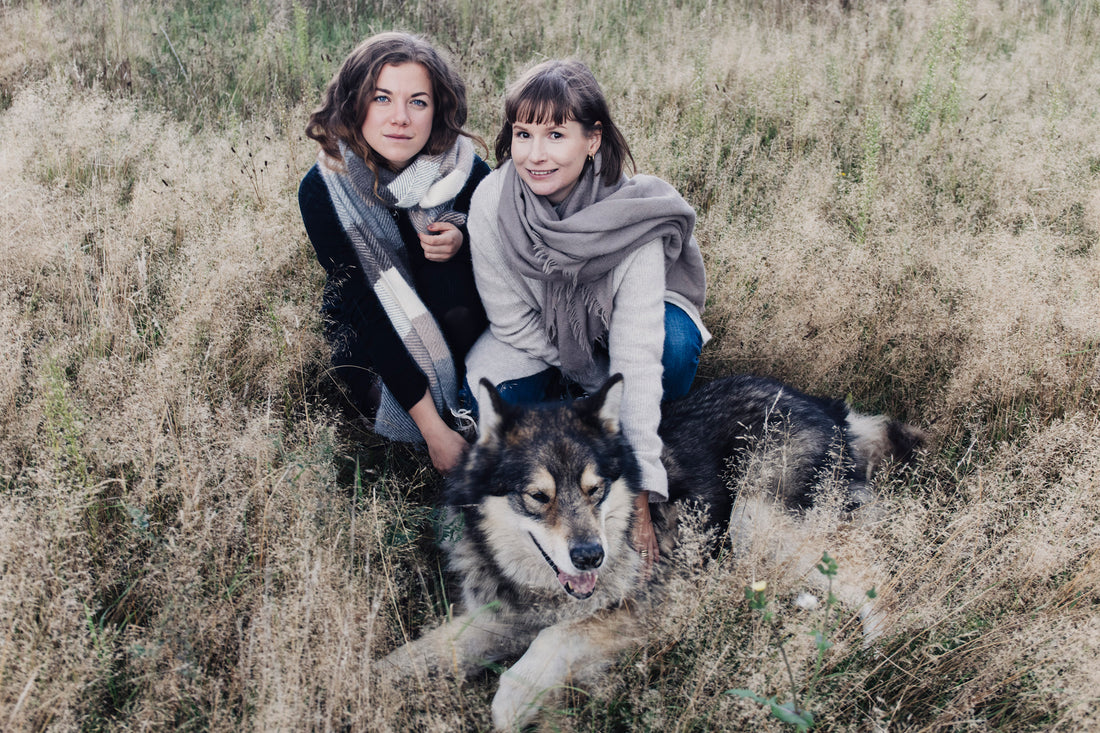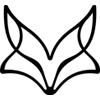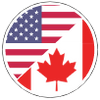Have you ever had a really, really good idea come to you out of the blue while you were just going about your day-to-day business? That’s pretty much what happened to Ann Cathrin Schönrock when she was looking for high-quality, sustainable, and animal-ethical yarn.
Together with her co-founder Franziska Uhl, she not only developed Chiengora®, a fine yarn made from dog wool, she also launched the label Modus Intarsia. And their journey is far from over. Right now, they’re in the process of developing yarn varieties from other types of pet hair. On top of that, they've founded YarnSustain, an association dedicated to rescuing raw materials, with which they aim to prevent as many usable resources as possible from landing in the trash can.
Wait a minute, a young, women-owned and sustainable company that is dedicated to giving unused raw materials a second life? "This should be promoted urgently!", thought the team in the fox's den and so it comes that Wildling Shoes has provided capital to YarnSustain. Without shares in return, because we know ourselves how valuable maximum freedom of choice is when it comes to your own business. In addition, Team Wildling supports Ann Cathrin and Franziska with entrepreneurial questions. For example, when it comes to networking or the supply chain.
Today we get to know YarnSustain a little better and co-founder Ann Cathrin is satisfying our insatiable Wildling curiosity by answering a few questions.
Ann Cathrin, tell us, have you always been a “dog person”?
We got my first dog when I was only three, and it makes me very happy that my daughter has had a loving fur baby in her life from the moment she was born. On average, we have always had about eight dogs in the family as a whole. My dog Emma has been with me for 11 years now. She’s an adopted cocker spaniel. So yes, I think I’ve always been a “dog person”. ;)
How did you come up with the idea of using dog hair as a raw material?
The starting point was actually my own need and my ambition as a fashion and knitwear designer to work with truly authentic, sustainable yarns. I wanted to work according to the principles of animal ethics, yet still create products that keep people warm. Besides that, I wanted to avoid plastic at all costs, and I also didn’t want to use materials that were difficult or impossible to recycle, or to sacrifice quality. There was nothing like that on the market.
While visiting my mother, we were busy brushing our three dogs and we suddenly had a huge pile of soft undercoat lying in front of us – and that’s when it struck me that we could use it to make yarn.
DA bit of research quickly revealed that there is a long tradition of handcrafting tiny amounts of dog wool into yarn. But you couldn’t buy it in a store. To this day, I’m still waiting in vain for the moment when I realize, “Aha, that’s why nobody is doing it.”
 Image: Stephanie Braun for Modus Intarsia
Image: Stephanie Braun for Modus Intarsia
And where do you get the fur?
We call on every single dog owner, dog lover, and dog grooming salon to collect the animals’ undercoat and send it to us so that together we can rescue this raw material from being wasted.
This can be done starting from even the smallest quantities, and if the weight exceeds 500 grams (approx. 1 lb), we even take care of the shipping. You can download a shipping form on our website.
How can we picture this? Do you just bring dog hair into a normal spinning mill?
Good question! We actually re-engineered the entire supply chain. You can’t buy dog wool in large quantities anywhere (which is fortunate for us as founders) and we now have access to an excellent network that covers all the supply chains that are relevant to us.
Can you give us a brief rundown of the production process? What are the challenges in terms of processing?
The high demands we place on the supply chain pose the greatest challenge. Having the fibers flown to Asia and back again for a single production step would be incompatible with our purpose, but the yarn industry in Germany has completely relocated elsewhere over the years. It’s difficult to find suitable partners in Europe at all, but we finally managed to do it. Since then, we’ve actually managed to bring one of the production steps, known as “deburring,” back to Germany by purchasing our own machine.
***
Info: “Deburring” is the name of the process by which the longer, coarser outer hairs (awns) are separated from the fine undercoat used for the yarn.
***
In the meantime, interested parties are approaching us and wanting us to handle this step of the production process. That means that both the need and the will to produce locally, but to pay a little more for it, are there.

Image: Stephanie Braun for Modus Intarsia
Compared with other types of wool, what are the properties of wool made from dog hair? And what’s the best way to care for the wool products?
Under a microscope, the undercoat of a dog is comparable to other premium fibers like cashmere. It’s actually almost better.
What do we base that on? Well, for one thing, on the fineness of the fibers. It’s measured in microns: the lower the value, the finer the fiber. Pure new wool, for example, has a micron value of around 35 nm or higher, fine merino has micron values between 21–32 nm, and lightweight cashmere is around 15–25 nm. With Chiengora® we range on average between 22–16 nm; the lowest value we’ve seen under the microscope was 11 nm.
Added to this is the fact that Chiengora®, like cashmere for instance, is a hollow fiber. That means, on the one hand, that it’s lighter as a result of that. On the other hand, it also provides increased thermal insulation, which makes it very resource-efficient to use.
The finished product, knitted from our fine industrial yarn, is as light and soft to the touch as cashmere. As a matter of fact, “Is that cashmere?” is a question we get a lot.
That comparison is also useful when it comes to care: Wash gently and place on a towel to dry, and treat the yarn just as you would treat any fine fiber. If a product made from Chiengora® isn’t dirty, just airing it out is all that’s needed. That conserves resources in the care process.
What obstacles and challenges did you face when you started your business? As a person perceived as female, how did you experience the start-up process?
Phew, where do I begin? At first it was very difficult to be taken seriously at all – both in terms of the idea and also as a woman. After all, the supporting scientific evidence and the proofs-of-concept only materialized bit by bit.
Thanks to an exceptionally good business and financial plan, we were able to successfully apply for the “EXIST” start-up grant.
Just a few months ago we had a very unfortunate episode, when an editor asked us during a shoot where the professor was who would be able to verify everything on camera (“You know, so we have someone who can say that it’s all true”).
And when it came to obtaining further funding, we also had a few very brazen requests from investors who openly dismissed our qualifications to our faces and wanted to run the business as a hobby.
That makes us all the happier about the awards and prizes we’ve won, as well as the sales figures on the account that confirm that we’re on the right track and that we can be confident in ourselves and our skills.

Image: Stephanie Braun for Modus Intarsia
When you started, dog wool was purely a niche product; how has it evolved since then?
We are very pleased that dog wool is gaining popularity, especially among handspinners. We consider the educational work about this raw material and about Chiengora®, which we developed from it, as one of our greatest tasks.
On one hand, we obviously think it’s fantastic that more people want to work with undercoats from pets, but it also comes at a risk for us.
We’ve spent years optimizing the process of Chiengora spinning, and the name Chiengora® signifies tremendously high quality standards, pure fibers, and no odors. That’s something you can’t develop overnight. But we certainly don’t begrudge all hand spinners or small spinning mills the opportunity to work with this wonderful material. Nevertheless, you have to make a clear distinction between the product qualities of the yarn.
Ultimately, dog wool or Chiengora® remains a niche yarn. Even when we will one day be able to save 100 tons or more from the trash can every year. The textile industry as a whole is operating on an entirely different scale.
What does “Modus Intarsia” actually mean?
I fell in love with knitting back when I was a kid. So it’s actually no surprise that I specialized in knitwear design while studying fashion and later honed my expertise in London.
My final project, which I began in parallel with the launch of the initial “save the dog wool” project, I knitted in the “Intarsia” knitting machine mode.
Intarsia knitting refers to a knitting technique that allows you to create something new and original by combining a wide variety of materials, haptics, and colors.
/p>
The idea of bringing all dog owners together around a sustainable business idea, scientific innovation, AND knitting is arguably as diverse and interdisciplinary as they come. That’s why the name “Modus Intarsia” is a wonderful fit if you ask me.

Image: Fashion Changers
What are your plans for the year ahead?
We’ve just founded an association to raise even greater awareness for raw material recovery in the community, and we’re constantly on the lookout for capable partners to expand this collectors’ network both nationally and even internationally. The vision for this is to collect as much raw material as possible.
At the same time, we have some exciting leads not only for our yarn, but also for some of our own products, which will be available in the online shop starting this fall.
Ann Cathrin, we are looking forward to everything you have in store and want to thank you for this fascinating interview!
If you are interested in giving the fur of your four-legged friend a new lease on life, you can visit the Modus Intarsia website to find all the information you need about sending in your dog's hair.
Cover image Stephanie Braun for Modus Intarsia



